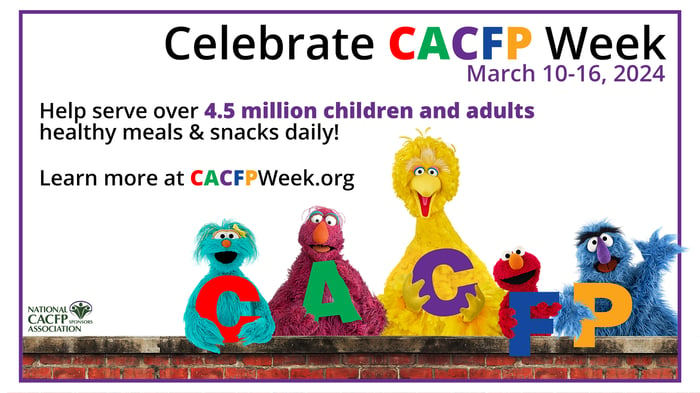Beyond the Map: How States Are Using Story Maps to Strengthen CACFP


Since 2019, Child Care Aware® of America (CCAoA) has partnered with Nemours Children’s Health to create geographic information system (GIS) technology story maps to visualize and better understand child care program participation in the Child and Adult Care Food Program (CACFP). Story maps combine both maps and text to help users interpret what they see. They can help us visualize current challenges and opportunities in a state’s early care and education systems.
This blog recaps our work to develop the story maps and explores how states, including Pennsylvania and Vermont, are using these tools to make data-informed, strategic decisions to promote CACFP and increase provider participation.
CACFP: Long-term Benefits, Low Participation
CACFP is a crucial federal program that brings nutritious food to, and builds positive eating habits for, children in center-based, home-based, and after-school care programs. It also helps child care providers cover some of the food costs for their programs through reimbursements for serving meals and snacks that meet federal nutrition standards. Centers and family child care programs may be approved to claim up to two reimbursable meals and one snack, or two snacks and one meal, for each eligible child per day.
Despite these numerous benefits, CACFP is underutilized across states for a myriad of well-documented reasons, including low awareness, inadequate reimbursement rates, and burdensome reporting and administrative requirements. Family child care programs, for example, are reimbursed at two different tiers of rates depending on their household income or the income of the families served. As a result, family child care providers who are eligible for the lower reimbursement rate may be hesitant to participate. A recent study shows that of all the licensed child care centers serving young children in 47 states and Washington, DC, just 36.5% participated in CACFP. Data shows that more than 46% of family child care providers participating in CACFP have exited the program since 1996. This has been exacerbated by the pandemic, which caused some CACFP-participating programs to either close their doors or limit enrollment, leading to a decrease in CACFP participation.
CACFP Story Map Development
Over the last five years, CCAoA has mapped CACFP participation across 20 states and Washington, D.C., who were granted technical assistance awards through Nemours Children’s Health. These CACFP story maps, which were developed with support from the Centers for Disease Control and Prevention, offer states a data-driven tool to identify gaps in CACFP participation and set goals to increase program uptake. You can find all our CACFP story maps here.
The story maps layer multiple data together. Specifically, the datasets featured on these maps include child care programs’ status in CACFP based on data received from the state grantees; food deserts from the United States Department of Agriculture (USDA); and the rate of families with children under 5 living below 185% of the Federal Poverty Level, from the US Census American Community Survey (ACS). CCAoA then used online GIS to display CACFP participation by provider, allowing us to identify successes and gaps in CACFP coverage alongside the locations of areas with low food access and high rates of families experiencing poverty.
The analysis included in these story maps is relatively uncommon and complex because of the lack of existing integrated or interoperable data systems— child care licensing data and CACFP participation data are typically housed within different state agencies and the datasets are often not compatible with each other. To address this issue, CCAoA engaged staff across multiple state agencies and departments, including from state health, early childhood, agriculture, and education offices, to bring these datasets together and confirm the analysis used in the story maps.
States overwhelmingly indicated in a survey that they would like to update their story map data in the future if given the opportunity, but there were barriers to making these updates on their own, including staff capacity, cost and a lack of reliable data. Since the project began, six states (Florida, Iowa, Louisiana, Maine, Pennsylvania, and Vermont) have returned to create a second version of the CACFP story maps.
Strategies for Change
Throughout the data gathering and story map development process, CCAoA engages state grantees in conversations around how they can use the story maps to take a data-driven approach to promote CACFP and increase program participation. These state-specific goals are included in the “Strategies for Change” section of the story maps. The tactics vary, but states have most often shared that they plan to use the story maps to target CACFP expansion efforts and boost general awareness, strengthen systems of support for providers and sponsoring agencies, and inform state and federal policymakers about the need for increased investments and policy change.
Given that the data in the maps is stagnant and represents CACFP participation at a point in time, there are some limitations to using the story maps for long-term strategic planning. State grantees shared that a point-in-time analysis, however, is still incredibly useful as a baseline because it gives stakeholders a better understanding of disparities and gaps in CACFP participation among providers. In our evaluation of this technical assistance experience, we found that state grantees were able to use their story maps as introductions to their state’s CACFP landscape with other state agencies, policymakers, and early childhood education stakeholders. Conversations around the story maps have led to coalition-building and propelled stakeholder interest in addressing the barriers providers experience with current CACFP requirements.
How States Are Using GIS Story Maps to Strengthen CACFP
The story maps yield robust data to help visualize gaps in CACFP participation and provide a basis for city and state leaders to make data-informed and strategic decisions that will increase children’s access to nutritious meals and help child care providers cover food costs for children.
In 2022, CCAoA surveyed state grantees to gather feedback about the story map development process and how states have used these tools. Given that the datasets for child care licensing and CACFP participation usually live in different state agencies, state grantees overwhelmingly noted that bringing multiple state agencies and/or departments together helped build stronger relationships and raise general awareness about CACFP participation across offices. One state grantee shared that this mapping opportunity helped break down intra-agency “silos” and increase mutual understanding of agencies’ roles, program limitations and data gaps. Another state grantee shared that the development of the tool is a testament to how different state agencies can successfully work together to use data to implement interventions, provide training, and collectively raise awareness of CACFP within their states. Externally, state grantees reported that the mapping opportunity helped develop new and strengthen existing partnerships with their CACFP sponsor organizations, child care resource and referral agencies, local food producers, local early childhood education stakeholders, food banks, United Ways, and other non–profit organizations.
State grantees responded that they have used the story maps to boost awareness of CACFP and tailor outreach to non-participating child care providers. The maps have been used to guide examinations of barriers to participation and focus efforts to determine where new sponsoring agencies are needed. The story maps have also been used by local communities and nutrition advocates to better understand, in a more tangible way, where outreach should be prioritized based on the overlays of participation and food desert data.
From the survey, states shared how they have used the story maps in various ways. In their own words, some examples include:
- Colorado: The map empowered our local Early Childhood Councils to understand the need for more food program access in their communities and to become local advocates for expanding program access.
- Iowa: We are using the map to inform our upcoming Ambassador stipends and our Farm-to-ECE Local Food Makes Cents program.
- Maine: This work has brought both relevance and reality to the front for our partners … [and has been] instrumental for continuation of conversations and focused efforts in areas of need.
- Texas: To prioritize certain geographic areas when expanding CACFP enrollment and obtaining feedback from child care providers about barriers and facilitators to CACFP.
- Washington, DC: We included it in conversations with the child care licensing team and subsidy team to inform CACFP outreach strategies included in agency policies. We plan to use it in our strategy to expand Farm-to-ECE. We’ve already used it in conversations with family daycare home sponsors to support utilization of the fiscal year 2023 increased Tier II reimbursement rates.
A Closer Look: Pennsylvania and Vermont
In June 2023, the Pennsylvania and Vermont state grantees presented how they are using their story maps at a virtual convening hosted by Nemours. Both states shared that they’re using the story maps to strengthen partnerships with other state organizations and agencies and to achieve lasting state systems change. Pennsylvania and Vermont are among the six states that returned to have a second, updated story map created.
Pennsylvania
CCAoA first developed a CACFP story map for Pennsylvania in 2019 and created a second story map for the state in 2023. The state grantee, the Department of Public Health, shared that they’ve used the map to:
- Engage statewide partners and build awareness of CACFP: Findings from their most recent story map suggest that only 36% of licensed providers were participating in CACFP as of February 2023, a majority (80%) of which were center-based programs. Low participation was consistent across the state: fewer than half of all providers participated in CACFP in 59 out of 67 counties. To boost awareness of CACFP and the map findings, the Department of Public Health widely disseminated the first version of its story map across its social media platforms and on their website. They also tapped longtime partners, Keystone Kids Go—a collaborative workgroup that has been actively working to improve the health of children, families, and early childhood education staff in Pennsylvania since 2002— to widely share the findings of the story map. In 2022, the state grantee shared the map with food security stakeholders participating in the Hunger-Free PA Task Force. The state has plans to continue using the map to engage partners and share it with the newly established Pennsylvania Statewide Food Policy Council.
- Identify areas of greatest need to better target interventions for providers and sponsors: The Department of Public Health used findings from both story maps to complete an analysis of CACFP participation rates from 2019 to 2022 to better understand the impact of the pandemic on the program. Pennsylvania saw a 6% decrease in CACFP participation during the pandemic, a loss of about 200 providers. Pennsylvania has also experienced a decrease in the number of sponsors, which is particularly troubling for the ability of family child care programs to participate in CACFP, as they must use a sponsoring agency to enroll in the program. The map is being used to determine where limited state resources should be targeted to help increase participation.
- Inform strategies in state and local plans that aim to address food and nutrition security: The story map was included as an asset in Pennsylvania’s most recent State Health Improvement Plan. Increasing awareness, eligibility, uptake, and utilization of CACFP is included as a strategy in the state’s plan to achieve a goal of increased financial well-being, food security, and safe affordable housing. At the local level, Children’s Hospital of Pittsburgh has used the map to support its REACH grant, a national program administered by the CDC to reduce racial and ethnic health disparities, with the Allegheny County Health Department. The project supports early childhood education sites in creating nutrition health guidelines and enrolling them in CACFP. Pittsburgh partners have used the map to locate providers within specific ZIP codes that the REACH grant defined as target audiences, conduct outreach to those who were not participating in CACFP and collaborate with various organizations to overcome barriers. Philadelphia’s Department of Public Health has also used the map at the local level to highlight the high percentage of children experiencing food insecurity and to demonstrate the complexity of food access issues in the city. They used the map to emphasize the need for continued support for CACFP participation for providers in Philadelphia. The Philadelphia Department of Public Health also shared the story map through their CACFP shared services workgroup.
- Advance interoperable data systems: During the initial development of their first story map, Pennsylvania discovered that there was no common identifier between the child care licensing database and the CACFP database, both of which are administered by the same state agency, but within separate departments. Through collaborative efforts, the two departments were able to garner support for the implementation of a common identifier in the CACFP database, which was recently implemented. Going forward, this will make pulling the data easier for future map updates and data briefs.
Vermont
CCAoA first developed a CACFP story map for the Vermont state grantee in 2022 and is currently in the process of creating a second, updated story map for the state. The Vermont Department of Health, Child Development Division, and Agency of Education, along with other early childhood education and nutrition stakeholders, were involved in the development of the original story map. They have shared that they’ve used the map to:
- Boost awareness and create space for coalition building: CACFP take-up has remained very low in Vermont—the story map finds that participation hovers around 21%. The state grantee noted one silver lining is that more early childhood partners are now engaging in conversations around universal nutrition access as a component within the early childhood system, and other partners have indicated their interest in joining coalition efforts. Conferences have been a fruitful avenue for the Vermont state grantee to share the CACFP story map findings with a range of audiences and gain new coalition partners. The CACFP story map was shared at the annual Vermont Association for the Education of Young Children (AEYC) conference, where over 80 educators attended a session to learn about the findings and indicated their strong interest in advocating for much-needed investments for CACFP. The story map findings were also highlighted at the state’s Hunger Action Conference and at the American Public Health Association’s annual conference. Sharing the data in these presentations has spurred interest and dialogue around the need for CACFP investments and growing the size of the coalition’s tent. University researchers offered to partner with the state grantee on future data-building efforts and conference attendees also indicated strong interest in being included in coalition conversations moving forward. The state grantee shared that they’ve also worked with the state’s Farm-to-School and Early Childhood Network to examine where additional connections to other network action teams might leverage momentum to think about integration more intentionally between the two programs.
- Educate state and local policymakers: In their survey response, the Vermont state grantee shared that the story map has provided an opportunity to key in additional state agency departments who have reviewed and will continue to review this data for policy and investment strategies. Vermont’s Early Childhood Advocacy Alliance shared the story map at its annual Early Childhood Day at the Legislature event to build general awareness with state policymakers. The state grantee also presented the findings of the map to multiple Building Bright Futures State Action Plan Committees and Regional Councils, both of which have followed up with requests for more information to better understand how to access and use the map in their regional and community-level planning efforts.
- Inform advocacy efforts: The state grantee shared that advocacy partners are accessing the data to advance equitable nutrition security at the state and federal levels through improved policy and investment.




